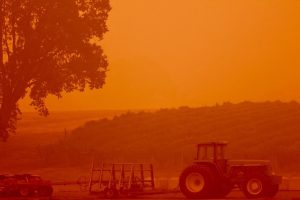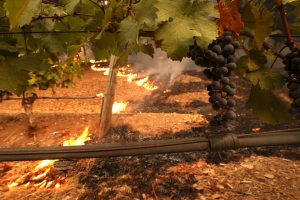
On September 12, Iverson Family Farms posted ominous images on social media of their fields under a ruddy red sky, thick with a stagnant, dense haze—a stark contrast to the vibrant annual Wooden Shoe Tulip Festival, a well-known spring attraction in Oregon’s Willamette Valley. As the Beachie Creek and Riverside fires raged roughly 25 miles away, the farm was in Stage 3 evacuation for 10 surreal autumn days.
It’s a scene that has played out throughout the western U.S. as roughly 40 large fires, amplified and accelerated by climate change, burned in September. The coastal states were most heavily impacted: California, in particular, has endured an unprecedented span of fire over the last two months. As of today, California’s devastating Glass Fire has damaged, if not destroyed, nearly 30 wineries in Napa and Sonoma counties.
Ash has been raining down on farm fields for weeks. Farmers of most crops—from fruit to lettuce—have been able to wash it away with minimal impact to operations, says Christopher Valadez, President of the Grower-Shipper Association of Central California. Still, since farmers don’t necessarily have the labor to clean produce, consumers have been advised to take extra precautions and wash fruits and vegetables thoroughly before eating them.
Luckily, Iverson Family Farms, a diverse, third-generation operation growing grass seed, tulips, wine grapes, and hemp, did not experience direct fire damage. Beyond worries over community losses, “I was concerned with embers that could have drifted onto the farms and ignited fields and homes,” says Giavanna Accurso, director of research and development for Iverson Family Farms and FSoil, the family’s hemp oil processing facility.
In grapes, smoke damage imparts a burnt, ashy, even medicinal taste to the resulting wine. When wood burns, it releases volatile compounds, called phenols, which can bind to grape sugars, only to be released during fermentation. Cannabis may also be similarly impacted by volatile compounds, and possibly other chemicals if buildings—and not just wildlands—burned nearby.
Wine Grape Quality in Question
The potential for widespread impact has left the labs that test grapes for smoke damage backlogged with requests, says California Farm Bureau Federation director of media relations, Dave Kranz. Tests that would typically take two to three days to process, are now taking several weeks, he says. A message on the website of California-based ETS Laboratories, one of the primary facilities able to test grapes, says they are unable to give customers a timeline to expect results.
One big difference this year is the fires occurred earlier in the season. During the October 2017 fires, only 10-15 percent of the crop was left on vines by the time the fires started, says Anita Oberholster, a viticulture specialist at University of California at Davis. “This year, the wildfires started when only 10 to 15 percent had been harvested; most grapes were still on the vine,” she adds.
“An estimate of the amount of smoke damage is really difficult,” says Oberholster. Glenn McGourty, a University of California viticulture advisor in Mendocino County, agrees. He says suspended particulates, which you can see in the atmosphere, don’t do much damage. It’s the volatile phenols, which are released in close proximity to the fire that can bind to the sugars in grapes to form compounds called glycosides. During fermentation, glycosides break apart, releasing the phenols that have a smoky flavor. In general, red wines, especially ones made with thin-skinned grapes like Pinot Noir, tend to be most affected. And that’s why it’s impossible to predict damage without testing.
Oberholster says that not every farm will necessarily be impacted. “Smoke exposure and risk is really complex,” she says. For example, only when smoke is really fresh is there a correlation between the density of smoke you see with the naked eye and actual exposure. And any breakdown of phenols in sunlight depends on atmospheric conditions. “We don’t know the half-life of [phenols], but there is some anecdotal evidence it could be 24 hours, maybe longer,” says Oberholster.
Oberholster advises growers to have their grapes tested if they experienced smoke at all, and especially if the wind blew fresh, dense smoke directly towards them. In the case of the current fire—the Glass Fire—raging in Napa and Sonoma, that could mean a lot of grapes.

555247 237941Glad to be one of numerous visitors on this awing website : D. 692954
Thanks so much!
Comments are closed.